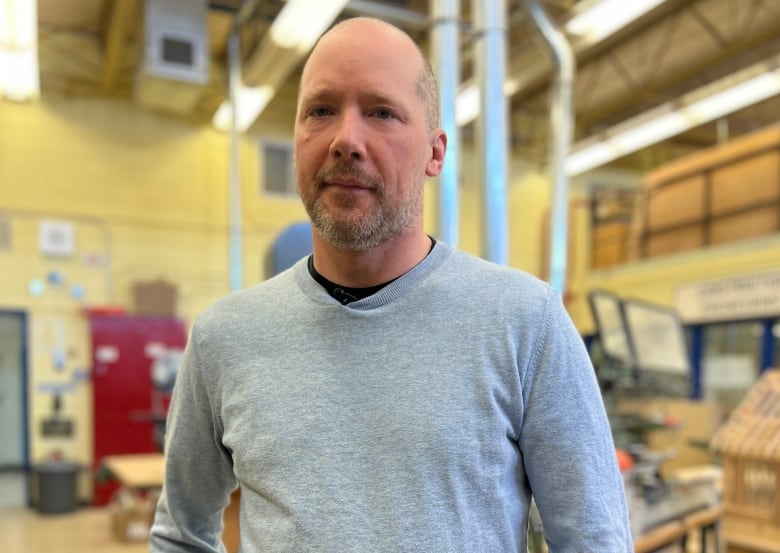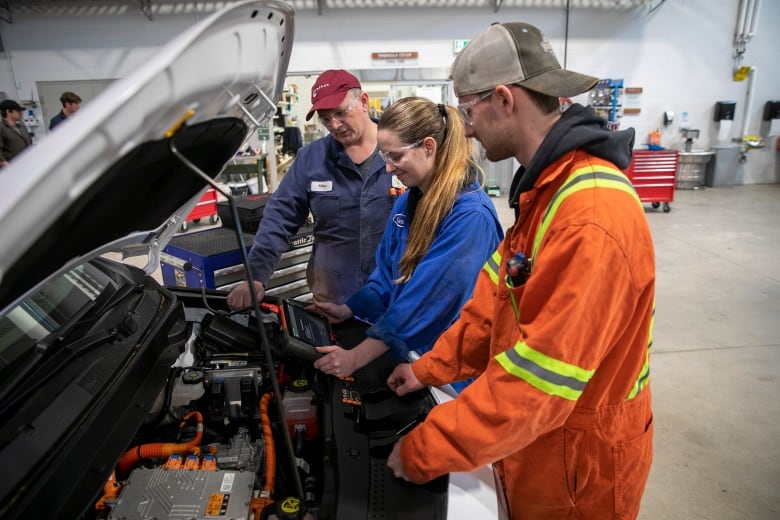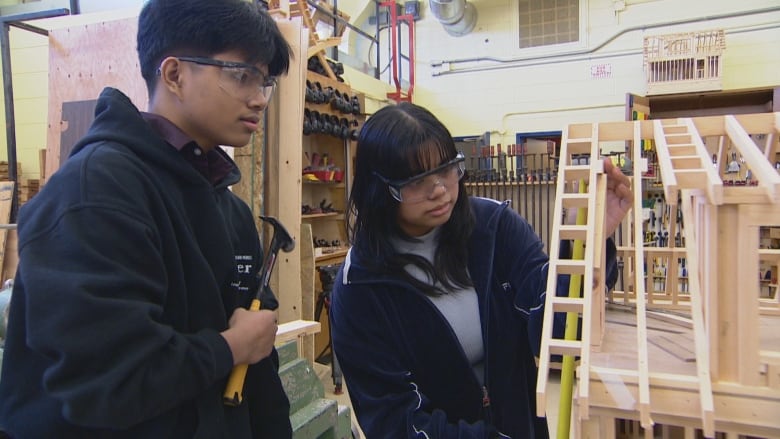Though he once considered dropping out of school, Grade 12 student Nathan Godet says he’s now showing up early thanks to an engaging course that marks the first time he’s ever enjoyed going to class.
The 17-year-old says his construction industry co-op course has reinforced his interest in the heating, ventilation and air conditioning (HVAC) industry — which he’d already been familiar with through family — and helped pinpoint a specialty to pursue: gas technician work.
“I don’t believe I would have been in school right now without this program,” said Godet. “I’d probably be working minimum wage right now.”
Classmate Khate Agne says the co-op course — where Toronto District School Board students learn at carefully selected construction sites — has helped broaden their horizons and offered the Grade 11 student a peek into different career paths.
“I could go to university, but slowly I’ve actually been starting to lean into … skilled trades,” said the 17-year-old, who has a budding interest in carpentry and construction management.
Canadians nearing retirement outnumber young people entering the working world, and demand for a new generation of skilled trades workers is soaring. Amid record high job vacancies in sectors like construction and manufacturing, new registrations for apprenticeship programs have risen, according to Statistics Canada. But the programs took a major hit during the pandemic, and apprenticeships and trade certifications have yet to catch up to pre-COVID-19 levels.
In a push to get young people interested in a career in trades, Ontario high schoolers will need a technical credit to graduate. The demand for trades workers is high, but there is also a need to attract from a wider demographic to meet the demand.
Provinces have responded to this labour shortfall in a variety of ways.
B.C. is boosting apprenticeship and foundation training seats, while Alberta is investing in skilled trades training for women. Last week, Ontario unveiled a mandatory technological education credit for high school students and is allowing young people to begin apprenticeships full-time starting in Grade 11.
But there are still several problems that need to be tackled, according to educators in the trades.

Teacher shortage
Elvy Moro, one of the two teachers leading Godet and Agne’s Step to Construction co-op class, has seen rising interest in the program over the past 17 years, as Canada’s need for younger tradespeople has increased.
His students sample many jobs in just a few months — they might spend a couple of weeks on-site with carpenters, followed by time with construction craft workers, sheet metal experts, electricians, plumbers and so forth. He calls it a phenomenally engaging, hands-on experience that helps many students figure out what fits.
“Our philosophy is to expose them to as much as possible and then give them that opportunity to make those important decisions in life — and help them to make the right decision,” Moro said.
But a key barrier standing in the way of these courses is a lack of educators, says Matthew Bradley, TDSB’s co-ordinator for the Ontario Youth Apprenticeship Program (OYAP), who popped into Moro’s shop last week.
The past decade has seen an overwhelming rise in demand for skilled tradespeople, as well as lucrative wages for the most coveted of them, but Bradley points out that this coincided with a doubling of the teacher-training period from one to two years for new Ontario educators. This is why he says it’s become less attractive for an experienced journeyperson to switch to newbie teacher — not to mention the significant pay cut he says comes with that switch.

“All across the province, there are widespread vacancies in shops like this because they don’t have a qualified teacher,” he explained, noting that better recognition of trades work experience for teachers in training and starting pay more comparable to what they made as skilled tradespeople would help more people to consider making the switch.
Raising the profile of the pathway to the skilled trades is also imperative, according to Bradley.
“Most people aren’t aware about apprenticeship at all,” he noted, calling it a common misconception among parents, students and the wider community that university and college are the only options after high school.
“From B.C. to Alberta, Ontario and the Maritimes, everyone is screaming for more skilled tradespeople,” he said. “We need employers, we need parents, we need guidance counsellors, we need teachers and students to all understand the value of the apprenticeship pathway.”

Framing skilled trades as ‘sexy’
Mandy Rennehan saw opportunity in the construction trades 30 years ago as a teen in Yarmouth, N.S. At the time, no one encouraged her in that direction despite her early interest and aptitude. Still, she forged ahead.
“Nobody at the high schools, none of my people around me were telling me — especially being female — to go into the skilled trades, because that’s not where [people] were going to be revered. That’s not where they were going to be praised,” the construction mogul and host of HGTV’s Trading Up with Mandy Rennehan recalled, in an interview from Naples, Fla.

These days, the founder and CEO of retail construction and maintenance company Freshco channels her decades of experience and passion for the skilled trades into advocating for them and dispelling the stigmas that can surround them. Like, for instance, the ideas that trades careers are back-breaking menial work, provide little intellectual stimulation, or that they’re simply not for women.
Rennehan describes tradespeople as polymaths that Canadians should value and be proud of and says what’s really needed is for the trades to be shown “for the sexy, essential industry it is, full of opportunities.”
Robotics, computer simulators, artificial intelligence, advanced tools and new technologies are transforming these careers in exciting ways that she says should command more respect and attention.
In turn, Rennehan says, the sectors themselves must double down on policies and workflows that make the trades a place where women and diverse communities feel they belong.
She believes the young apprentices of today will change the trades from within since they’ve learned more about racism, discrimination and the importance of tolerance, equality and inclusion than prior generations.
“More women and more young men who come into the trades [valuing equality] is really going to help the industry.”

Ongoing learning, training ‘super critical’
After running his own repair shop for nearly two decades, Mike Bocsik returned to Camosun College, his Victoria alma mater, where he’s spent the past 12 years as an automotive instructor.
In his experience, today’s students want to be fully engaged in what they’re learning and are hungry for depth, detail and up-to-date industry developments. According to Bocsik, that means instructors have to be “on their game.”
Regardless of how long tradespeople have been working, he points out that they need regular, ongoing training to keep up with technological advancements — which arrive nearly every quarter for the automotive industry.
“If you let things stagnate, you’re going to [fall] behind,” he said. “It’s super critical to continue with the upgrading and just move forward.”

Bocsik says his students “want to start doing something right now,” which works out well, since he says employers in the industry are constantly approaching the college looking for new apprentices.
He believes the education sector and trades industries should collaborate to create more outlets and facilities for students to learn and get hands-on experience to get started in jobs quickly.
Some programs — like Camosun’s automotive training that covers the rapidly expanding electric vehicle industry — currently have wait lists several years long.
Another initiative Bocsik would like to see happen soon is more opportunities for veteran journeypeople — including those nearing retirement — to pass on their decades of knowledge and guide younger colleagues toward full and satisfying careers.
While he says the best path for the sector going forward would be to focus on the idea of the trades a career as opposed to just a job, Bocsik also notes the current labour shortage means apprentices can get work quickly.
“If you want it, you’re going to get it.”














Leave a comment